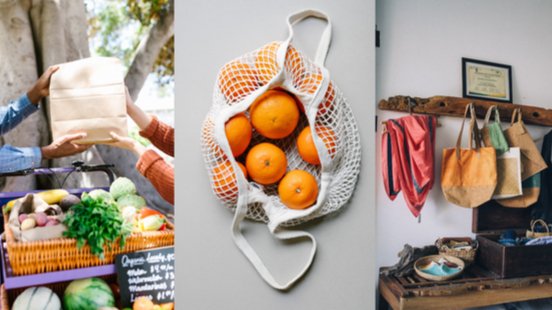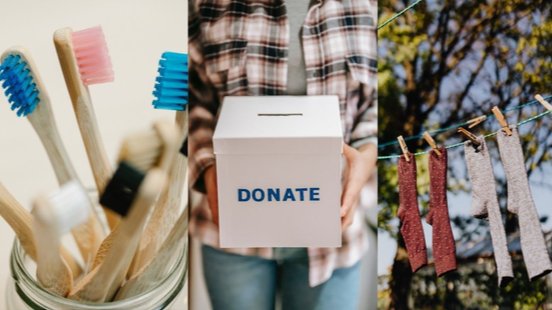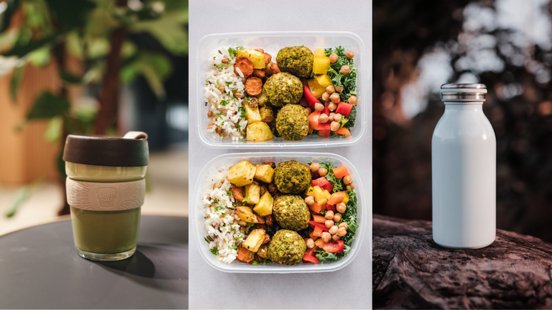I have spent a few days putting together a list of zero waste lifestyle tips. A lot of these things are very easy to do, it just takes a little bit of commitment.
Hopefully they will help you make a smoother transition towards a less wasteful lifestyle.
THE 8 R’S OF ZERO WASTE LIVING

#1 Reduce
Reducing the overall amount of waste is crucial for our shared sustainable future. The average American produces more than 4 pounds of trash daily (according to EPA), which amounts to roughly 254 millions tons of trash per year collectively.
Potentially everything you buy and own can turn into waste so a good idea before buying anything new or used is to give yourself an honest answer to the question: “Do I really need this?”
For example, if you already have a bottle of shampoo at home (or 2, or 3…), maybe that extra one is really not all that necessary.
#2 Refuse
Try to say “no” to anything and everything that has potential to become instant waste: single use plastic bags, plastic straws and utensils, paper plates, anything with lots of packaging, anything with a word disposable or single-use in it (coffee cups, cameras, paper towels etc.)…
It comes down to refusing to create more trash.
#3 Reuse & Repurpose
These are some things around the household that can be reused: wrapping paper, plastic bags, boxes.
Outgrown or old clothes you can give to friends or charity or you can use them as kitchen cloth.
Buy beverages and other items in returnable containers.
You can also sell things you don’t need anymore, like books you have read, or clothes you grew tired of.
Reusing and repurposing reduces air, water and land pollution, limits the need for new natural resources, such as timber, petroleum, fibers and other materials and greatly enhances your zero waste living.
#4 Refill
There are more and more so-called refill stations where you bring your empty containers, and fill them back up with goods.
The individual products differ from store to store, but most offer unscented versions of personal care items like shampoos and lotions that are also free of additives and preservatives like sulfates, phthalates and parabens.
If you look around your house you will see that many things we use in our everyday lives are refillable: perfumes, cartridge toners, cleaning products, deodorants, hand soaps, dish soap, pens…
#5 Repair
If you are not handy yourself, find a local tailor to help you with clothing repairs.
If your phone or laptop is broken, instead of purchasing a new one, seek repair options first.
When you start implementing this principle you will see that it saves money as well.
#6 Regift
If you want to do it right, make gifts out of your unused items, and items that hold no sentimental value. Also, make sure it is a good fit for the recipient, and make it look nice.
#23 explains more about wrapping your gifts in a sustainable manner.
All in all, it isn’t about unloading unwanted stuff on your friends and family, it is about giving someone something they’ll cherish more than you would have.
All in all, it isn’t about unloading unwanted stuff on your friends and family, it is about giving someone something they’ll cherish more than you would have.
#7 Recycle
Recycling is a key component of modern waste reduction. Whenever possible, make sure to recycle.
Every recycled item is one less item that would have otherwise ended up in our oceans or landfill sites.
However, recycling still takes a lot of energy. So, maybe it is a better idea not to buy certain products altogether and reduce the amount you recycle.
Zero waste is about recycling less not more.
WHEN YOU GO SHOPPING

#1 Buy in Bulk
When grocery shopping, this way of buying can help eliminate huge amounts of waste that disposable containers generate.
It is also very cost effective since most items cost less when you buy them in bulk.
To locate a bulk store by you, check out the Zero Waste Home bulk store.
Another online bulk shopping guide can be found through the Zero Waste Grocery Guide. You can search for local options by state.
#2 Carry a Reusable Shopping Bag(s)
Try to completely eliminate plastic bags and plastic produce bags. Always carry with you at least one reusable shopping bag.
Put one or two in your car if you own one. You never know when they can come handy.
#3 Buy Objects Once
When you choose to purchase high-quality items you will only need to pay a considerable amount once. These items will pay themselves off over time.
Every product uses natural resources.
However, if you buy high-quality items, you no longer need to keep buying more products so less materials is used.
That also reduces the amount of waste, because you no longer need to dispose of items as often as before.
Surround yourself with tools and items that are meant to last a lifetime.
#4 Shop at Farmers’ Markets
Food in the U.S. travels great distances to get to the supermarkets.
All this shipping uses large amounts of natural resources, contributes to pollution, and creates trash with extra packaging.
Food at the farmers market is transported shorter distances and is generally grown using methods that minimize the impact on the earth.
Shopping at farmers’ markets is one of the best ways to connect with where your food comes from by meeting and talking to farmers and food artisans.
You can also get tips on how to cook the ingredients you buy, because they often offer plenty of advice about how to cook the foods they are selling.
One great recipe I got like that was to trim kohlrabi and peel it very thoroughly, then slice it like bread and spread peanut butter on it.
I use raw peanuts that I roast myself and then blend them to get peanut butter. On top of it I put a bit of honey 😀
#5 Shop Second Hand
When it comes to clothes, according to the World Bank, the fashion industry is responsible for 10% of annual global carbon emissions.
That is more than all international flights and maritime shipping combined.
Buying second hand saves good clothing from landfills and reduces the demand for clothing production.
While it is always best to shop locally, there are numerous online thrift stores for you to check out.
Don’t forget, there are many more things besides clothes that you can buy second hand: furniture, books, electronics, baby gear, cars, different tools, kids toys, home care items, musical instruments, video games…
#6 Borrow Rather Than Buy
If you are looking for a specialty item, like camping gear, car roof rack or an extra table for a party, ask a friend if you can borrow one before making a purchase.
If you can’t borrow, check out one of the advertisement websites. People often list and sell things that are barely used and in good condition.
IN YOUR OWN HOME

#1 Stop Using Paper Towels
Usually paper towels are treated with heavy chemicals, bleaches and dyes to make them white and sturdy enough to absorb water without falling apart.
They cannot be recycled because they are considered ‘contaminated waste’ so they mostly end up in landfills.
As they break down they generate methane, a gas 25 times as potent as carbon dioxide at trapping heat in the atmosphere.
Try to replace them with, for example, reusable bamboo paper towels which can withstand up to 100 washes.
You can also make a bunch of cloth towels out of your old t-shirt.
You should try and avoid any single use items in your household, and paper towels are one of them.
#2 Beeswax Food Wraps
Beeswax wraps consist of coated fabric, usually cotton, which is infused with food-grade beeswax, rosin, coconut oil, and jojoba oil.
The wrap can be shaped around containers or food. They are an excellent alternative to plastic wraps, and can be reused again and again.
#3 Keep The Leftovers
When I did my exchange year in the US quite a few years ago, I was astonished by the amount of food waste my host family would make and subsequently throw in the bin every day.
Check out these leftover recipes from WeHateToWaste.com. Whatever can’t be salvaged should be composted if there is any chance.
#4 Bamboo Toothbrushes
Bamboo is the fastest growing plant on Earth, and it is considered a type of grass not wood.
According to Wikipedia certain species of bamboo can grow 910 mm (36 in) within a 24-hour period, at a rate of almost 40 mm an hour.
Because the handle of these toothbrushes (and usually the packaging) is biodegradable, you can put it into your compost after you’re done with it.
You could also reuse it in your garden as a plant stake.
Don’t forget to pluck the bristles out of the toothbrush before composting. Even though some companies claim so, there still isn’t any sustainable alternative to this.
Don’t forget to turn the water off while brushing your teeth. 🙂
#5 Line Dry Clothes
Dryers are bad for the environment and for your clothes. Dryer shrinks, fades clothing, and wears them away.
That is the lint you find in your dryer, which is basically your clothes wearing away.
However, people use them because they are convenient and save time and space.
Another big reason dryers are so popular is that a lot of Americans believe visible laundry drying is unsightly.
But, one can also air dry inside. Just remember to air the house out to prevent the forming of mold.
Some sustainable practices are not the most convenient, and they take getting used to. So it comes down to your own personal why.
Even though sometimes you will have to make significant changes in your life, those practices do save money in the long run.
In this particular case – electricity bills and money that you would otherwise spend on buying new clothes.
#6 Use Laundry Detergent Stripes
Those are eco-friendly detergent substitutes that don’t contain all sorts of questionable ingredients. And they are also great because they come in recyclable paper packages.
#7 Put a Bucket in the Shower
I visited Cape Town in 2017, and at that time they were experiencing severe drought. Water restrictions were very high with alarm bells going off.
One of the ways my friend was battling the situation was that he had put a bucket in his shower.
So, while you wait for the water to get warmer you let it run in the bucket, and afterwards you can flush the toilet with it.
I was so impressed by that idea of saving water, so since then I have implemented it in my own home as well.
#8 Run a Full Dishwasher Or Washing Machine
Always run a full load of dishes or clothes.
Also, try washing clothes when they are actually dirty, instead of after only one wear.
#9 Compost
Good news is that you don’t have to live in the countryside to have a compost pile.
There are so many tips on how to make one if you live in a flat as well.
Of course, there is a whole science on how to make your compost pile.
Here is a list of things you can compost:
- Fruit scraps
- Vegetable scraps
- Coffee grounds
- Eggshells (though they can take a while to break down)
- Grass and plant clippings
- Dry leaves
- Finely chopped wood and bark chips
- Shredded newspaper
- Straw
- Sawdust from untreated wood
What NOT to compost:
- Anything containing meat, oil, fat, or grease
- Diseased plant materials
- Sawdust or chips from pressure-treated wood
- Dog or cat feces
- Dairy products
#10 Use Recycled Toilet Paper
Firstly, let’s get this out of the way – recycled toilet paper is not made of toilet paper. It is made out of recycled paper such as textbooks and office paper.
Using any kind of recycled paper means fewer trees are cut down.
A lot of people don’t think about this and for them recycling is only about the collecting part.
But for recycling to succeed, a company needs to turn that collected stuff into a product, and someone needs to buy that product.
Buying recycled toilet paper is a great way to close the loop.
Bear in mind that tissue products made from 100 percent recycled paper are not as soft as standard tissue products.
Another sustainable kind of toilet paper is the one made out of bamboo.
It is softer than the recycled versions, and the fibers in bamboo are naturally antibacterial, anti-fungal and odor resistant.
#11 Dispose Items Properly
Learn where to properly dispose of items like gift cards, old cell phones, batteries and unusable cords.
Most of them can be turned in at Best Buy etc.
#12 Donate
Donating items to thrift stores helps keeping your unwanted belongings out of the landfill.
Make sure that the items are in good condition, otherwise the thrift stores will likely throw them in the trash anyway.
WHEN YOU FEEL INSPIRED

#1 Wrap Presents in Newspaper Or Not at All
Stanford University estimates that Americans throw away 25% more trash during the Thanksgiving to New Year’s holiday period.
The extra waste amounts to 25 million tons of garbage, or about 1 million extra tons per week!
To reduce this waste, you can carefully unwrap presents, so that the wrapping paper can be reused.
When you wrap presents for others, use the paper you already have laying around the house.
It is almost guaranteed that your presents will stand out if wrapped in newspaper. Here are some ideas on how to do it.
Also, pebble offers some great ideas on how to wrap presents in fabric.
Have fun!
#2 Get Creative
Try and find ways to upcycle the items into something new.
For example, instead of throwing away your old denim jeans, you could make an upcycled denim rag rug or a tote bag.
If you are very creative you can even make proper art out of broken stuff around your house.
With this one, the sky truly is the limit!
WHEN YOU ARE OUT AND ABOUT & AT WORK

#1 Bring Your Lunch With You
Disposable lunches (to-go packaging, plastic utensils, etc.) generate a lot of trash. You can avoid that by packing your lunch in a reusable container.
Preparing your own food will also allow you to eat healthier and usually cheaper.
#2 Take Public transport to Work
Apart from the obvious – reduction of carbon footprint and easing congestion, taking public transport can potentially be a less stressful journey.
You can have your own time, take a nap even, read and people watch; not to mention save money.
You also don’t have to worry about finding a parking space.
The use of public transport will ensure you walk between the stations and places you’ll be boarding the buses or trains, so you will spend more time outside.
Feeling the air and the weather in the mornings and afternoons can be a wonderful thing, instead of just going from one enclosed space to the other.
Another great way to get to work is to cycle (if you are not bothered by your hair potentially getting messy 🙂
#3 Have Your Own To-Go Coffee Cup
Bring your own to-go cup when getting coffee on the run instead of getting a paper cup.
Disposable paper cups cannot be recycled and end up in landfill.
The quality of paper with the inner lining of wax or plastic makes them difficult to recycle into other items.
Another reason for that is because of the contamination left in the cups.
#4 Get a Reusable Water Bottle
Just as important as actually owning a reusable water bottle is to fill it up before you leave the house.
You want to avoid finding yourself in a situation where you have to buy water, because there wasn’t any adequate place to fill up your water bottle.
#5 Use Less Paper
While at work you could take notes on your laptop and communicate with your colleagues via email or text messages, rather than using paper.
Consider going paperless for all the bills.
Use both sides of the paper when you write.
So, What Next?
Even though adopting a Zero Waste lifestyle is one of the most sustainable ways of living, the concept of living entirely waste-free takes a bit of getting used to, so take your time – it is a journey not a destination.
How to actually start?
Choose 3 steps from the list that seem the easiest to you.
Then every month, or whenever they become second nature add 2 more.
As you get used to the changes you make in your everyday life they become habits and so you make way for more sustainable living goals.
I’m rooting for you! 🙂
